Advertisement
Field Guide to Boston
A New Englanders' guide to catching the April solar eclipse
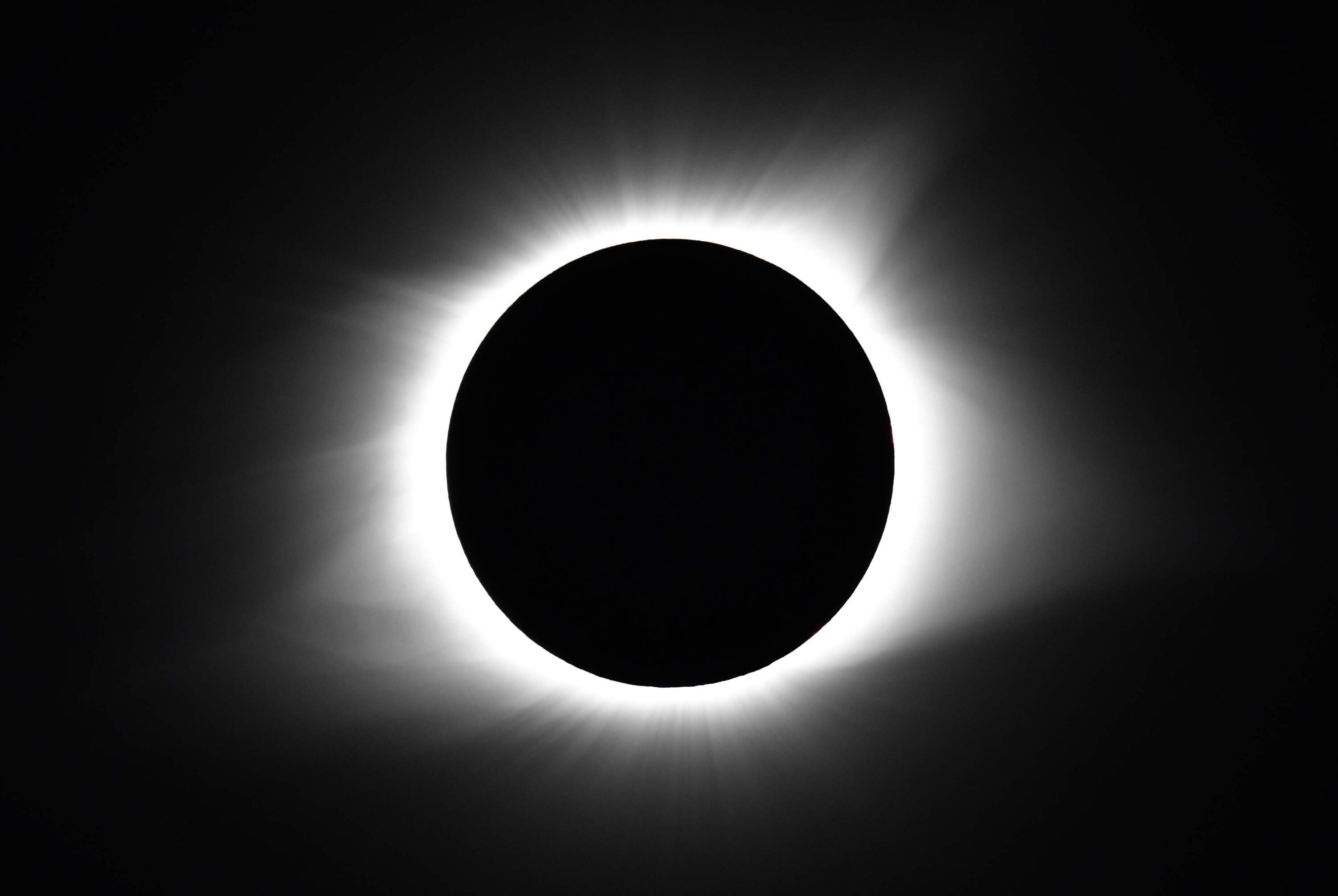
It's not every day the moon blocks people's view of the sun. It's even rarer to witness a total eclipse. For many of us, we finally are in the right spot, at the right time.
A total solar eclipse is set to occur on Monday, April 8, and northern New England is in a prime spot to see the phenomenon. It will be another 20 years before there's a total solar eclipse in the contiguous United States.
What to expect
During a solar eclipse, the moon blocks people's view of the sun. Depending on where you're located, it'll partially block the sun or completely cover it.
Full coverage of the sun by the moon is called a state of "totality." If you're lucky enough to be in the path of totality, the complete coverage of the sun usually lasts between three and four minutes, according to NASA. Viewers in the path of totality could expect to see the sun's corona — the outermost portion of the sun's atmosphere — which is usually hidden by the the star's brightness.
The sudden daytime darkness could trick some nocturnal animals in the area to awaken, thinking the day has ended.
NASA has an interactive map that tracks the eclipse's journey across the Earth by the fraction of a second.
Keep in mind, viewing such an event is all contingent on clear weather. On April 8, we'll cross our fingers for a clear afternoon. The weather is looking good in New England.
Major New England spots in the 'path'
The path of totality is cruising right through areas of northern New England, and you've hit the jackpot if you're in certain areas of Vermont, New Hampshire or Maine. Residents of the other states — Massachusetts, Rhode Island and Connecticut — are less lucky and will only see a partial eclipse.
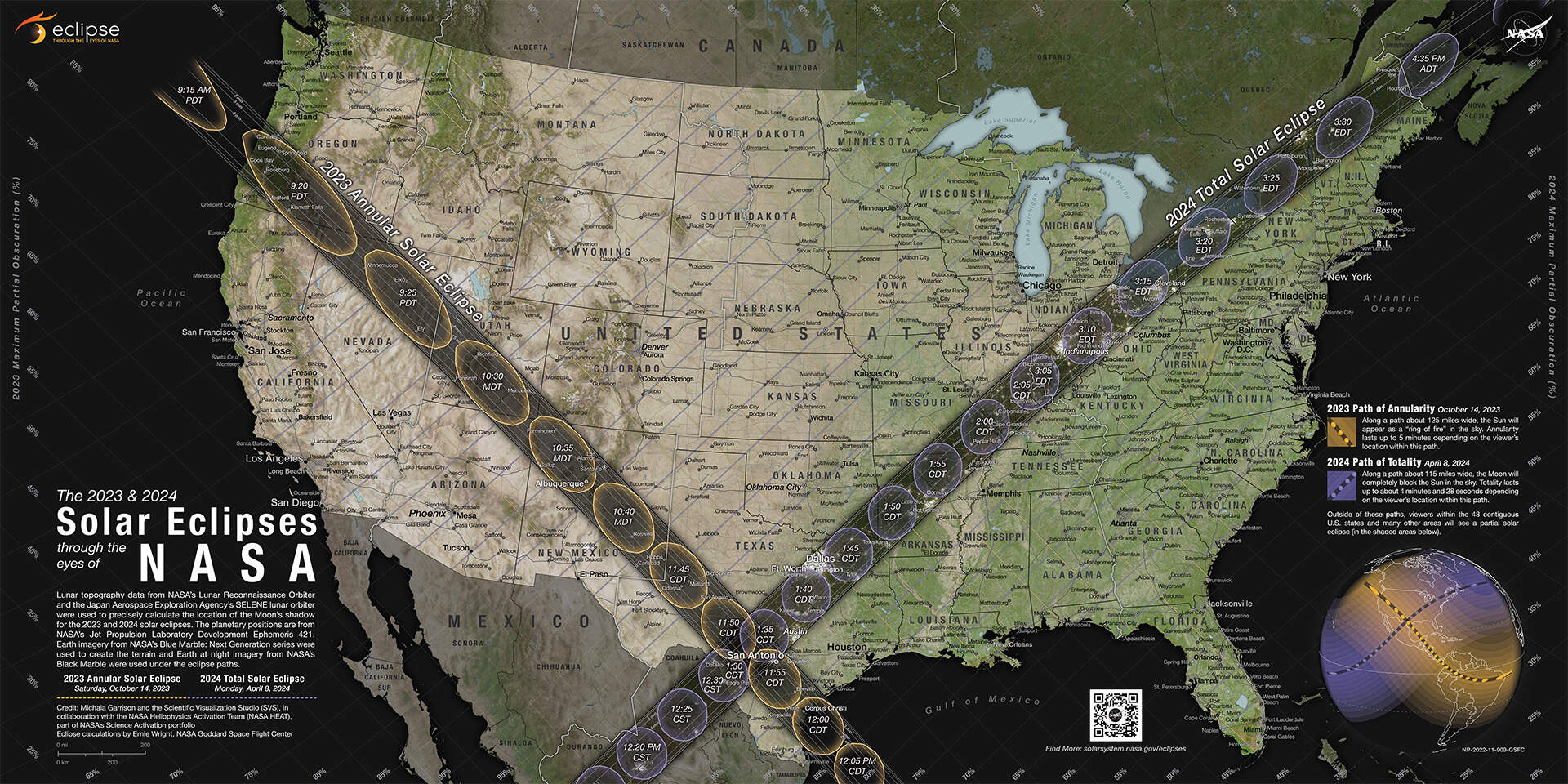
NASA identified the more populated areas in New England that are within the path of totality. Check out the times listed below if you're planning to watch the astronomical event.
Burlington, Vermont:
- Partial eclipse beginning at 2:14 p.m.
- Total eclipse beginning at 3:26 p.m.
- Eclipse peak at 3:27 p.m.
- Eclipse ends at 4:37 p.m.
Lancaster, New Hampshire:
- Partial eclipse beginning at 2:16 p.m.
- Total eclipse beginning at 3:27 p.m.
- Eclipse peak at 3:29 p.m.
- Eclipse ends at 4:38 p.m.
Caribou, Maine:
- Partial eclipse beginning at 2:22 p.m.
- Total eclipse beginning at 3:32 p.m.
- Eclipse peak at 3:33 p.m.
- Eclipse ends at 4:40 p.m.
A partial solar eclipse will be visible far beyond the path of totality. In Boston, the partial eclipse will begin at 2:16 p.m. and end at 4:39 p.m. The peak (with about 93% coverage) will occur at 3:29 p.m.
Safety
Let us be clear: staring directly at the sun will damage your eyes. The longer you gawk, the more damage you could do to your retinal cells. Even a quick, direct glance can cause damage.
Staring at an eclipse in progress is no different, but there are safe ways to visually take in the event.
The most common is with solar viewing glasses, according to the American Astronomical Society. These are not your ordinary sunglasses, by the way; they're thousands of times darker. If you plan on using these specialized glasses, just make sure they're made with the right solar filters. Look on the inside of the glasses frame to see if the glasses are compliant with the ISO 12312-2 international safety standards.
Many local libraries are giving away eclipse glasses while supplies last. Or you could purchase them through various venders — but be wary of buying a fake. The American Astronomical Society has a list of suppliers who sell approved glasses.
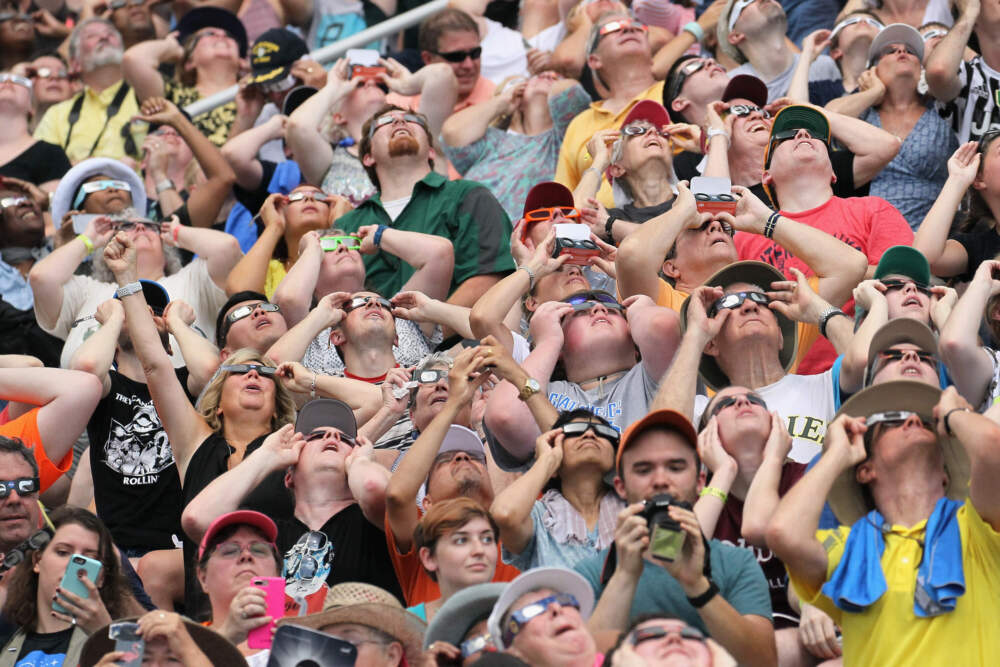
The glasses aren't a panacea, however. Don't look at the sun "through camera lens, telescope, binoculars, or any other optical device while wearing eclipse glasses or using a handheld solar viewer — the concentrated solar rays will burn through the filter and cause serious eye injury," states NASA.
If you can't get your hands on eclipse glasses or a handheld solar viewer, you could try an indirect viewing methods like a pinhole projection.
With all that said, there is one exception. If you're viewing the solar eclipse in the path of totality and the sun is completely covered by the moon, it is safe to look at it. It's the moments leading up to the state of totality that can cause damage, according to NASA.
"When the bright photosphere of the sun is completely covered, only the faint light from the corona is visible, and this radiation is too weak to have any harmful effects on the human retina," NASA said in a total solar eclipse FAQ. "There is a misunderstanding that during a total solar eclipse, when the moon has fully blocked the light from the sun, there are still harmful rays that can injure your eyes. This is false."
Even with that very specific caveat, just be smart about viewing if you're planning to check out the event. A safe eclipse viewing is a great eclipse viewing!
Traveling for the eclipse
Northern New England is bracing for a flood of visitors to see the total solar eclipse. The Vermont tourism agency expects many tens of thousands of visitors to join them for the event (and are recalling an influx of visitors for a weekend of Phish concerts in 2004 to plan for traffic and anticipate problems).
For months, businesses and tourism officials in Vermont, New Hampshire and Maine have been talking up local attractions and suggesting visitors make a long weekend of it. Many of these northern communities offer natural beauty, great restaurants and local shopping.
April can be a beautiful time of the year in New England. April can also be a terrible time of the year in New England. The biggest concern for eclipse experts is the high probability of clouds, which would obscure the view of totality. There is also a good chance it will be cold, rainy or even snowing. And of course, it’s mud season.
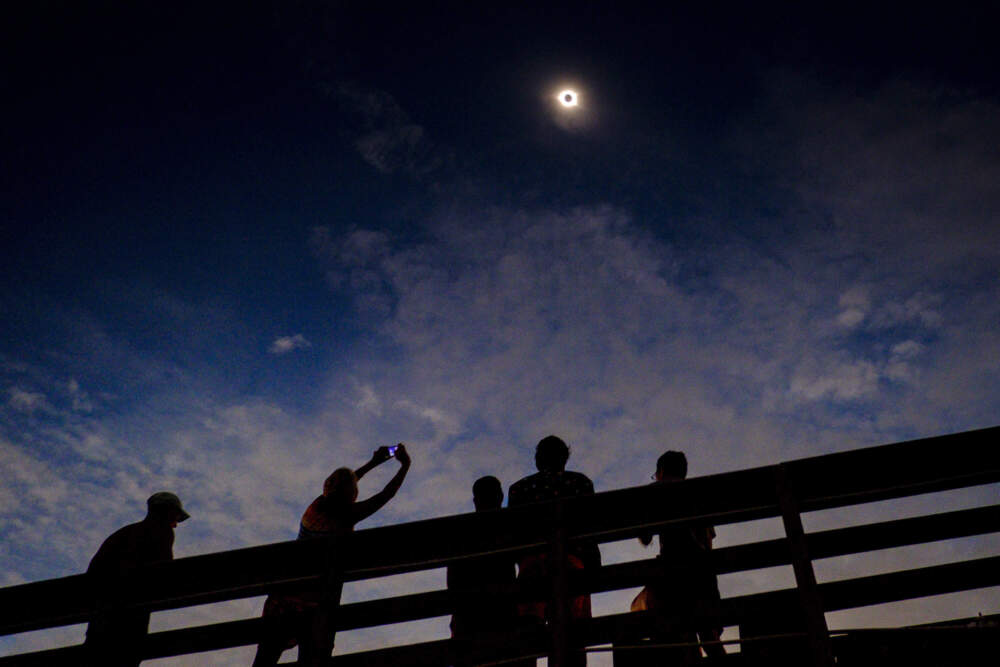
Lodging
Some visitors made their plans long in advance. Many hotels and short term rentals in northern New England are fully booked or booking up fast. Considering the full range of totality could help you find a community where there are still lodging options.
Camping
If you’re thinking about making your eclipse experience a camping trip, you may find limited options. Maine’s Baxter State Park, which is in the line of totality, is closed to camping. State park campgrounds across the region generally don’t open until May. You may find more luck with private campgrounds in Maine, New Hampshire or Vermont.
With camping, officials are issuing strong warnings. Maine officials say camping on public lands in April is “inadvisable to all but those who are self-sufficient and fully prepared to deal with difficult and highly changeable conditions.”
Road conditions
People who have experienced a total eclipse in the past recommend not traveling on the day of the eclipse to avoid traffic.
Officials are anticipating much more traffic than normal on April 8, with people driving both long and short distances for a better view.
In New Hampshire, state officials are urging visitors to “arrive early, stay late” and to expect delays, given the limited number of roads in and out of the state’s North Country. In addition, they say drivers should not pull over on the side of the road to view the eclipse, lest they get stuck in mud or snow (and get laughed at by the locals).
Mountains
Ski areas in Vermont and Maine that are in the path of totality say they will close lifts during totality. Vermont’s Jay Peak will have parking attendants on site for visitors in its parking lot. People are not permitted to park on the highway leading to the mountain, and staff will help clear the roads if needed.
Several state officials have warned people to stay off dirt roads and hiking trails. The Green Mountain Club of Vermont has said most trails in that state will be closed. In Maine, officials at Baxter State Park are suggesting visitors consider other venues.
Eclipse events in New England
Finding the eclipse is easy: Just look up. But if you want to enjoy the celestial show with others, there are plenty of eclipse watch parties and events happening. (For ticketed events, be sure to check availability before you get your hopes up since some are sold out.)
Cities and towns along the path of totality are planning viewing parties, parades and concerts. These events will also help them manage crowd flow and enforce designated parking areas. There's plenty of fun to be had in areas of partial totality as well.
Here are just a few:
Vermont
- Here are seven of Burlington's official viewing sites to experience totality.
- The city of Burlington has a full calendar of eclipse events including talks, comedy shows and parties.
- In Glover, the Bread and Puppet Theater will hold an eclipse ritual, involving hymns to the sun and exorcism to banish everything evil.
- The Camp Hochelaga YMCA camp in South Hero is hosting a non-ticketed gathering with local musicians and vendors, with a suggested donation.
(Click here to see a full list of eclipse events from Vermont Public.)
New Hampshire
Events in the path of totality:
- Coleman State Park in Stewartstown, right in the path of totality, is hosting something they’re calling Total Eclipse of the Parks. (Get it?) The park will be open for eclipse viewing, with food, refreshments, and activities for kids. Parking is limited, so you’ll need a reservation.
- The Great North Woods Center for the Arts near Colebrook is hosting an eclipse concert on the evening of the big event, at 7 p,m.
Further south, some events will celebrate the partial eclipse:
- You can watch the partial eclipse and participate in a drum circle at Mystery Hill (aka America’s Stonehenge) in Salem, New Hampshire.
- The McAuliffe-Shepard Discovery Center in Concord is throwing a viewing party from noon to 5 p.m.
(The state of New Hampshire has a list of public events, celebrations and eclipse gatherings.)
Maine
- Houlton will host a major celebration leading up to and on April 8. Events include a metaphysical eclipse tent and a bus tour to a nearby planetarium.
- In Millinocket, runners will gather for Millinockeclipse, a casual run set to take place during the length of the eclipse. There will also be a town festival, which includes a whoopie pie bake-off.
- In Rangeley, the Rangeley Lakes Heritage Trust is holding a Shadow of the Sun Festival and highlighting International Dark Sky Week.
(Here's a list of events from the Maine Office of Tourism.)
Massachusetts
If you're in the Greater Boston area and can't make the trip to northern New England, you can see a partial eclipse. And that may not be as spectacular, but it's still pretty cool.
- Spectacle Island: The name alone makes this Boston Harbor Island a fun place to watch the eclipse. The ferry departs at 1 p.m. and will not wait for you, so be sure to arrive at Long Wharf North by 12:30 p.m. Tickets cost $15 - $20.40.
- Fresh Pond, Cambridge: As a rule, events near a water treatment facility don't sound like a good time, but in this case that facility is at Kingsley Park in Fresh Pond. The Cambridge Water Department-hosted event will feature music, eclipse-related experiments, free viewing glasses and more. The fun starts at 2 p.m.
- Larz Anderson Park, Brookline: Enjoy the show in the sky in the leafiest-green spot in leafy-green Brookline. Organizers say they'll hand a limited number of eclipse-safe glasses to hand out, but better to bring your own if you have them. The event starts at 1:30 p.m.
- EcoTarium, Worcester: The always-fun EcoTarium is offering free admission on Eclipse Day. Folks bring their own picnic lunch to the Sundial Plaza, or they can take part in several educator-led programs before the big show begins. Doors open at noon.
- The Massachusetts Department of Conservation and Recreation has a list of events spanning the state, from the craggy Atlantic shores of Rockport to the state's highest point, Mount Greylock, in the Berkshires. Each location will have its share of events. You can find the location nearest you here.
Future eclipses
If you aren't in the area for this total solar eclipse, don't fret. There are more eclipses ahead with different paths across the globe.
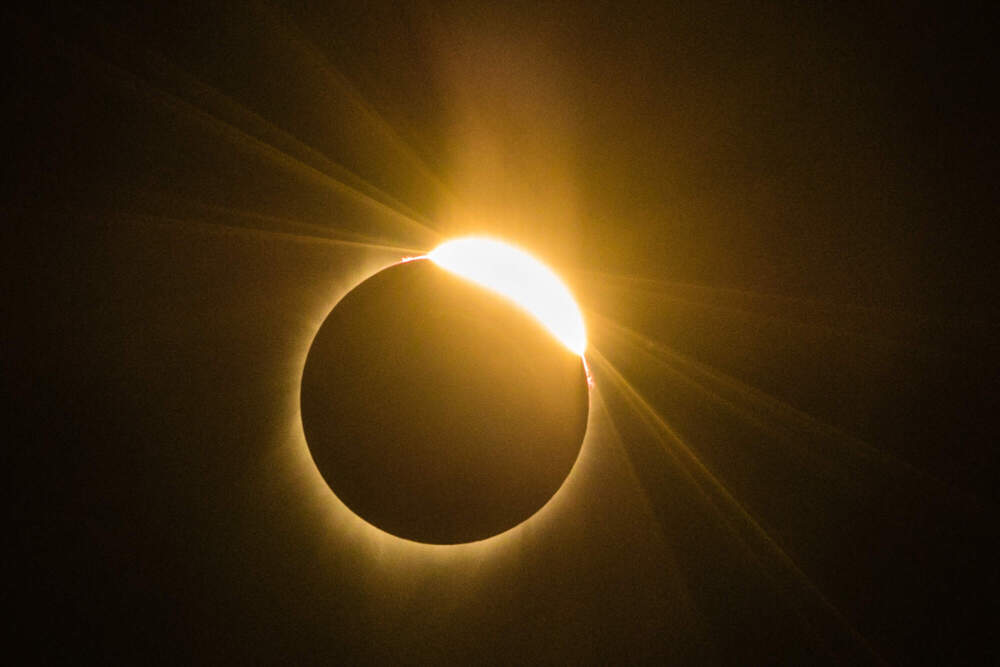
NASA compiled future eclipse dates and regions if you're looking to plan ahead. It just depends on where you are — it's all about being at the right place at the right time (although we realize the ones in Antarctica may just be out of the question).
The difference between a total solar eclipse and an annular solar eclipse is how far the moon is from the earth.
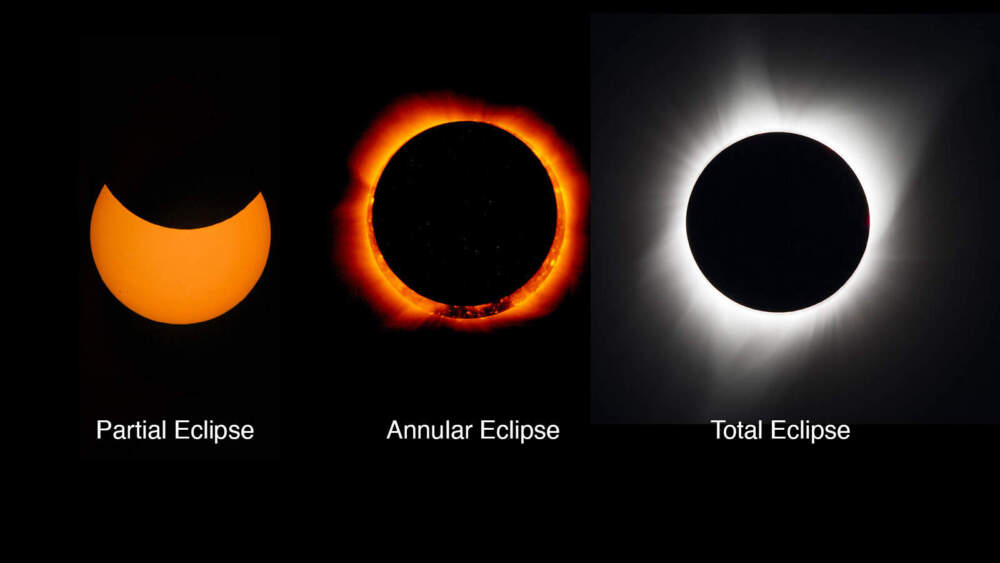
In a total solar eclipse — like the one happening April 8 — the moon is closer to the earth, therefore appearing larger and completely blocking the sun. Viewers can see the sun's corona which is typically overpowered by the sun's bright surface. In an annular solar eclipse, the moon is farther away in its orbit from the earth, so it does not completely cover the sun's surface from view. Viewers will see what's often called a "ring of fire" in the sky.
Here's a look at upcoming celestial events:
- Oct. 2, 2024: An annular solar eclipse will be visible in South America, and a partial eclipse will be visible in South America, Antarctica, Pacific Ocean, Atlantic Ocean, North America
- March 29, 2025: A partial solar eclipse will be visible in Europe, Asia, Africa, North America, South America, Atlantic Ocean, Arctic Ocean
- Sept. 21, 2025: A partial solar eclipse will be visible in Australia, Antarctica, Pacific Ocean, Atlantic Ocean
- Feb. 17, 2026: An annular solar eclipse will be visible in Antarctica, and a partial eclipse will be visible in Antarctica, Africa, South America, Pacific Ocean, Atlantic Ocean, and Indian Ocean
- Aug. 12, 2026: A total solar eclipse will be visible in Greenland, Iceland, Spain, Russia, and a small area of Portugal, while a partial eclipse will be visible in Europe, Africa, North America, the Atlantic Ocean, Arctic Ocean, and Pacific Ocean
With additional reporting by staff at Vermont Public, New Hampshire Public Radio, Maine Public and WBUR's Amy Gorel, Nik DeCosta-Klipa and Roberto Scalese.
This article was originally published on February 28, 2024.

